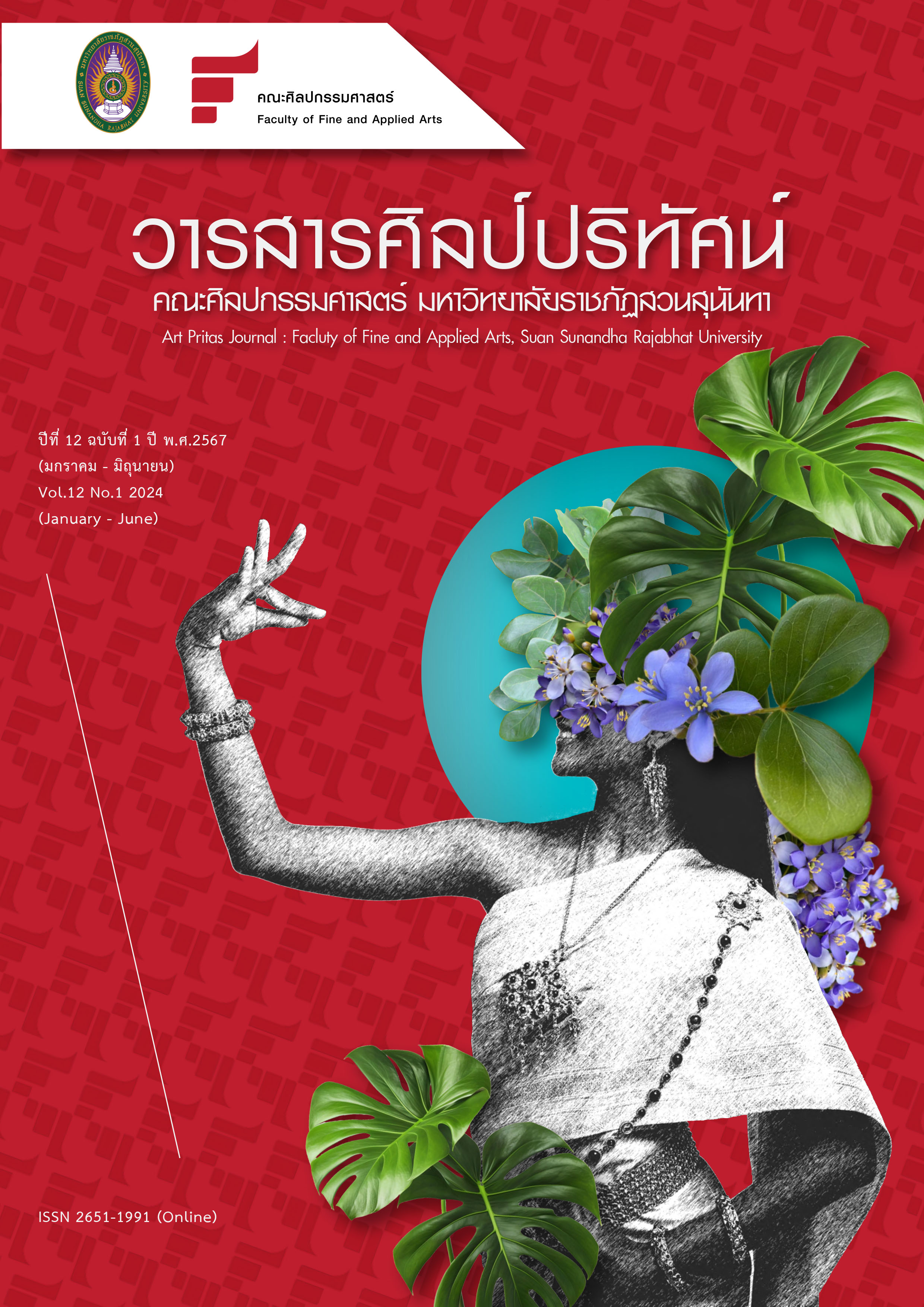การพัฒนาเส้นใยในนาเกลือหวาน จังหวัดปัตตานี ด้วยแนวคิดความยั่งยืน สำหรับกลุ่มเป้าหมายรีดักชั่นนิส ในตลาดเอเชียตะวันออกเฉียงใต้
Main Article Content
บทคัดย่อ
งานวิจัยนี้มีวัตถุประสงค์ เพื่อ 1) หาแนวทางในการพัฒนานวัตกรรมสิ่งทอจากนาเกลือหวาน จังหวัดปัตตานี 2) เพื่อหาแนวทางการออกแบบสร้างสรรค์รูปแบบเครื่องแต่งกายสตรี สำหรับกลุ่มเป้าหมายรีดักชั่นนิส (Reductionists) ในตลาดเอเชียตะวันออกเฉียงใต้ จากการพัฒนาเส้นใยในนาเกลือหวาน จังหวัดปัตตานี ใช้ในรูปแบบวิจัยเชิงทดลอง (Experimental Research) ด้วยแนวคิดความยั่งยืนที่สอดคล้องกับแผนยุทธศาสตร์การขับเคลื่อนด้วยโมเดลเศรษฐกิจ BCG การพัฒนานวัตกรรมสิ่งทอจากนาเกลือหวาน จังหวัดปัตตานี ซึ่งเปนทรัพยากรทางการเกรษตรที่เป็นเอกลักษณ์ในพื้นที่ โดยปัจจุบันการทำนาเกลือลดจำนวนลงเรื่อย ๆ เนื่องจากมีผลกระทบในด้านของพื้นที่ และเป็นอาชีพที่มีรายได้ไม่ยังยืน ชาวบ้านที่ทำนาเกลือจึงมีรายได้ที่ไม่เพียงพอต่อการเลี้ยงชีพของคนในครอบครัว ผู้วิจัยจึงค้นคว้าการพัฒนานวัตกรรมเส้นใยในนาเกลือ จังหวัดปัตตานี ที่สามารถนํามาพัฒนาได้หลายรูปแบบให้เกิดเป็นผลิตภัณฑ์ในรูปแบบใหม่ เพื่อให้เกิดเป็นผลิตภัณฑ์ด้านสิ่งทอและเป็นที่รองรับการเปดการคาที่มีแนวโนมเติบโตมากขึ้นในตลาดระดับสากล เพื่อขยายตลาดและขยายการหารายได้ให้กับคนในชุมชน โดยกระบวนการย้อมสีธรรมชาติซึ่งเป็นกระบวนการที่ชาวบ้านในพื้นที่มีความรู้ความสามารถในด้านภูมิปัญญาที่สืบทอดกันมา การวิจัยนี้จัดทำขึ้นโดยมีขั้นตอนการดำเนินงาน 2 ขั้นตอนได้แก่ ขั้นตอนที่ 1) ศึกษาข้อมูลทุติยภูมิ คือ ศึกษาทรัพยากรทางภูมิศาสตร์ในนาเกลือ จังหวัดปัตตานี และศึกษาการสกัดสีเพื่อย้อมสีจากทรัพยากรธรรมชาติในนาเกลือ จังหวัดปัตตานี ขั้นตอนที่ 2) ศึกษาข้อมูลปฐมภูมิ คือ ลงพื้นที่เพื่อเก็บข้อมูลทรัพยากรในนาเกลือ และทำการทดลองสกัดสีจากพืชสเป๊ะ (ผักเบี้ย) และโคลนบริเวณนาเกลือ จังหวัดปัตตานี เพื่อทดลองย้อมสีและวิเคราะห์หาข้อสรุป จึงพบว่า เมื่อสกัดสีจากทรัพยากรในนาเกลือหวาน จังหวัดปัตตานี จะให้สีที่มีความอ่อนละมุน และค่อนไปทางตุ่นและอ่อนมาก เนื่องจากแร่ธาตุในดินมีความเจือจางกว่านาเกลือในจังหวัดอื่นๆ ซึ่งพืชที่พบมากในบริเวณนาเกลือ คือ พืชสเป๊ะ (ผักเบี้ย) เมื่อสกัดสีมาแล้ว มีค่า PH อยู่ที่ 4.5 จะให้สีเหลืองอ่อนอมครีม เมื่อย้อมแล้วเส้นใยมีจะมีความนุ่มและไม่มีกลิ่น ต่อมาคือ โคลนในนาเกลือหวาน จังหวัดปัตตานี เมื่อนำมาสกัดแล้ว มีค่า PH อยู่ที่ 6.5 จะได้สีเหลืองตุ่นอมส้ม เมื่อย้อมแล้วเส้นใยมีจะมีความแข็งกระด่าง ซึ่งน้ำเกลือหวานจะอยู่ในขั้นตอนของการหมักเพื่อเตรียมเส้นใยการก่อนย้อมในสีธรรมชาติที่เตรียมไว้ และหมักน้ำเกลืออีกครั้งหลังจากนำไปแช่ในสารช่วยย้อม (Mordant) ส่งผลให้สีมีความอิ่มตัวที่ต่างกัน (Saturation) และระดับของสีทีต่างกัน (Palate Colors)
ดังนั้นการพัฒนาเส้นใยในนาเกลือ จังหวัดปัตตานี ยังช่วยส่งเสริมและการต่อยอดทรัพยากรอันเป็นอัตลักษณ์ของภูมิปัญญาท้องถิ่นให้คนในชุมชนมีรายได้ และเห็นคุณค่าในการพัฒนาเพื่อนำมาเป็นสินค้าไลฟ์สไตล์ให้เกิดความน่าสนใจ ในกระแสนิยมของความยั่งยืน โดยสิ่งทอที่ได้จากการพัฒนาในครั้งนี้อีด้วย ยังเป็นการนำวัตถุดิบในท้องถิ่นมาปรับใช้ให้เกิดประโยชน์สูงสุดอีกด้วย
Article Details

อนุญาตภายใต้เงื่อนไข Creative Commons Attribution-NonCommercial-NoDerivatives 4.0 International License.
เนื้อหาและข้อมูลในบทความที่ลงตีพิมพ์ในวารสารศิลป์ปริทัศน์ ถือเป็นข้อคิดเห็นและความรับผิดชอบของผู้เขียนบทความโดยตรง ซึ่งกองบรรณาธิการวารสารไม่จำเป็นต้องเห็นด้วย หรือร่วมรับผิดชอบใดๆ
บทความ ข้อมูล เนื้อหา รูปภาพ ฯลฯ ที่ได้รับการตีพิมพ์ในวารสารศิลป์ปริทัศน์ถือเป็นลิขสิทธิ์ของวารสารศิลป์ปริทัศน์
เอกสารอ้างอิง
ปรีดา ศรีสุวรรณ และพัดชา อุทิศวรรณกุล. (2562). การออกแบบแฟชั่นยั่งยืน. Veridian E-Journal, Silpakorn University, 12(5), 711-728. https://he02.tci-thaijo.org/index.php/Veridian-E-Journal/ article/view/182016
พัดชา อุทิศวรรณกลุ, สิริรัตน์ จารุจินดา และทีมผู้วิจัย. (2563). โครงการเพิ่มมูลค่านวัตกรรมสิ่งทอในผลิตภัณฑ์แฟชั่นไลฟ์สไตล์จากฐานการผลิตจังหวัดน่านสู่ตลาดเมืองหลวงพระบาง. กรุงเทพฯ: คณะกรรมการส่งเสริมวิทยาศาสตร์วิจัยและนวตักรรม (สกสว.).
พัดชา อุทิศวรรณกุล. (2565). การจัดการบริหารสินค้าแฟชั่น (ฉบับปรับปรุง) (พิมพ์ครั้งที่ 6). กรุงเทพฯ: หน่วยวิจัยแฟชั่นและนฤมิตรศิลป์ ภาควิชานฤมิตรศิลป์คณะ ศิลปกรรมศาสตร์ จุฬาลงกรณ์มหาวิทยาลัย.
สำนักศิลปากรที่ 11 สงขลา. (2563). นาเกลือเมืองปัตตานี. สืบค้น ตุลาคม 2, 2566 จาก https://www.finearts.go.th/fad11/view/26117-นาเกลือเมือง
สุวนาถ ทองสองยอด, และภีรกาญจน์ ไค่นุ่นนา. (2561). แนวทางการพัฒนาช่องทางการตลาดของผลิตภัณฑ์เกลือตำบลบานา จังหวัดปัตตานี. ปัตตานี: คณะวิทยาการสื่อสาร มหาวิทยาลัยสงขลานครินทร์ วิทยาเขตปัตตานี.
Greennetworkthailand. (2564). COP26 กับบทบาทประเทศไทย ในการรับมือการเปลี่ยนแปลงสภาพภูมิอากาศ. สืบค้น ตุลาคม 2, 2566 จาก https://www.greennetworkthailand.com/cop26-ประเทศไทย/
Laura Yiannakou. (2566). The Reductionists. สืบค้น สิงหาคม 8, 2566 จาก https://www.wgsn.com/en


